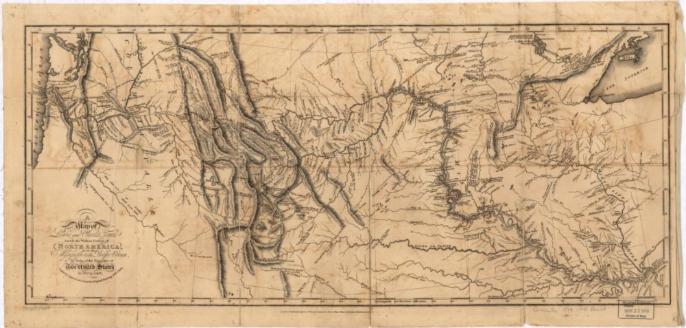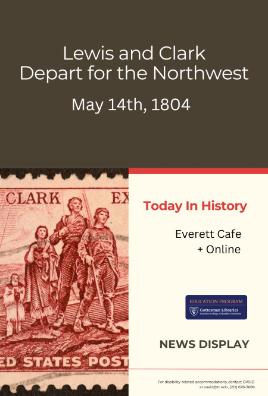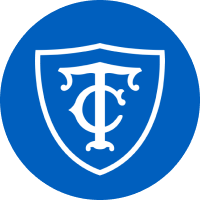Today In History: Lewis and Clark Depart for the Northwest

May 14, 1804. Off we sailed! Well, not exactly. Upriver meant just that -- against the current. Most of the time we were standing up to our wastes in mud. Pushing. Or standing on the crumbly, sandy riverbanks, pulling that hunk-o'-wood keelboat along with ropes. Snakes slithered around our legs, and oh, those mosquitoes!
When we met our first group of Indians, from the Oto and Missouri tribes, they laughed at us. Our uniforms -- what was left of them -- were muddy and bedraggled, and here we were pulling an ungainly wooden box. The Captains put on a grand show to impress them. Captain Clark shot off a noisy air gun. Captain Lewis read a long speech about the Indians' Great Father Jefferson back in Washington, and gave them a bunch of medals and trinkets.-- Private Reubin Field, Member of the Corps of Discovery, The Great Expedition of Lewis and Clark.
On May 14th, 1804 Meriwether Lewis and William Clark began an expedition to explore the United States' newly acquired Louisiana Purchase and land in the West. The Corps of Discovery journey, which began in Illinois along the Missouri River and ended near Fort Clatsop, Oregon, was commissioned by President Thomas Jefferson and lasted two years. The Lewis and Clark National Historic Trail is close to 5,000 miles long and one that connects 16 states through varied terrain and waters.
The expedition team comprised members of the U.S. army, as well as civilian volunteers led by Lewis, a military captain and future governor of the Louisiana Territory, and military officer Clark, later the Governor of the Missouri Territory and Superintendent of Indian Affairs. By November they reached Knife River Village in present-day North Dakota where they met Sacagawea, a young Shoshone Native American woman, and her husband Toussaint Charbonneau, a Quebecois trapper; the couple joined the expedition as interpreters. Sacagawea played a critical role in sharing local knowledge and advice, as well in diplomatic relations with indigenous peoples.
The team endured harsh weather, dangerous rivers, starvation, illness and injury, but they successfully mapped the Missouri River to reach the Pacific Ocean, discovering new plant and animal species and valuable information about the West and its inhabitants.
The following articles are drawn from Proquest Historical Newspapers, which informs and inspires classroom teaching and learning.
- Romantic Figures of American History. (1944, Jul 16). Chicago Daily Tribune (1923-1963)
- Davis, J. E. 1949, Feb 13). Lewis and Clark Spent 2 Years on Jet Route. The Washington Post (1923-1954)
- Dobie, J. F. (1953, Nov 15). Lewis, Clark and a Vast, Young Land. New York Herald Tribune (1926-1962)
- News of the World of Stamps: Historic Scene Depicted on Lewis and Clark Commemorative. (1954, Jun 27). New York Times (1923-)
- Beddow, R. (1984, Mar 11). Beyond the Wide Missouri: The Journals of the Lewis and Clark Expedition. The Washington Post (1974-)
- Theroux, A. (1996, Mar 03). The Epic Journey of Capt. Lewis: A Young Man's Life on an Incredible Expedition. Chicago Tribune (1963-1996)
- Henderson, K. (1997, Oct 30). Story of Lewis and Clark Provokes Imagination. The Christian Science Monitor (1908-)
- Stroud, T. (2000, Feb 06). The Resourceful Traveler. Chicago Tribune (1997-)
- Axtman, K. (2004, May 14). Lewis and Clark . .. and the Indians: A Bicentennial's Delicate Balance. The Christian Science Monitor (1908-)
- Petty, M. (2006, Sep 21). History Along the Route of Intrepid Explorers. The Washington Post (1974-)

After the keelboat carrying Lewis's collection of plants and other scientific specimens from the lower Missouri River arrived in St. Louis in May 1805, the specimens were sent by boat to New Orleans, then on to Washington by way of Baltimore. They finally arrived in August. Jefferson was at Monticello, so he didn't get to look at things until early September. He then sent them to the American Philosophical Society in Philadelphia. He instructed the society to give the dried specimens to Dr. Benjamin Smith Barton, who was supposed to examine the collection and make a report. -- Dorothy Hinshaw Patent, Plants on the Trail with Lewis and Clark. p. 72.
Tips:
- Adler, David A, and Ronald Himler. A Picture Book of Lewis and Clark. First edition. New York: Holiday House, 2003. Curriculum ; F592.7 .A34 2003.
- Crutchfield, James A, Rebecca Spears Schwartz, and Rue Anne Wood. Lewis & Clark Expedition, 1804-1806. Amawalk, N.Y: Jackdaw Publications, 1995. Curriculum ; F592.7 .L48 1995.
- Dalton, David A. The Natural World of Lewis and Clark. 1st ed. Columbia, Mo: University of Missouri Press, 2008. e-book.
- Dillon, Richard H. Meriwether Lewis ; A Biography. New York: Coward-McCann, 1965. 5th Floor Stacks & Loft ; F592.7 .L678.
- Draper, A. S. (Andrew Sloan), and Lewis and Clark Centennial Exposition. Unsettled Questions in the Organization and Administration of the Schools an Address by Andrew S. Draper at the National Educational Congress, Lewis & Clark Exposition, Portland, Ore. August 28, 1905. Portland, Or: [publisher not identified], 1905. History of Education Collection, Teachers College Digital Collections.
- Edwards, Judith, and Sally Wern Comport. The Great Expedition of Lewis and Clark : By Private Reubin Field, Member of the Corps of Discovery. First edition. New York: Farrar Straus Giroux, 2003. Curriculum ; F592.7 .E38 2003.
- Herbert, Janis. Lewis and Clark for Kids : Their Journey of Discovery with 21 Activities. 1st ed. Chicago: Chicago Review Press, 2000. e-book.
- Kroll, Steven, and Richard Williams. Lewis and Clark : Explorers of the American West. New York: Holiday House, 1994. Curriculum ; F592.7 .K76 1994.
- Lewis, Meriwether. History of the Expedition under the Command of Captains Lewis & Clark, to the Sources of the Missouri, Thence across the Rocky Mountains and down the River Columbia to the Pacific Ocean, Performed during the Years 1804-5-6, by Order of the Government of the United States : V. 3. vol. 3. England: D. Nutt, 1905. e-book.
- O’Dell, Scott. Streams to the River, River to the Sea : A Novel of Sacagawea. Boston: Houghton Mifflin, 1986. Closed Stacks Juvenile ; PZ7.O237 St 1986.
- Patent, Dorothy Hinshaw, and William Muñoz. Plants on the Trail with Lewis and Clark. New York: Clarion Books, 2003. Curriculum ; F592.7 .P376 2003.
Images:
- Lewis, Samuel, 1753 Or, et al. A Map of Lewis and Clark's Track Across the Western Portion of North America, from the Mississippi to the Pacific Ocean: By Order of the Executive of the United States in , 5 & 6. London: Longman, Hurst, Rees, Orme & Brown, 1804. Courtesy of Library of Congress.
- Lewis and Clark Postage Stamp, Courtesy of Canva.
Need to keep current, look to the past, teach a topic? The Everett Cafe features daily postings of news from around the world, and also promotes awareness of historical events from an educational context. Be sure to check additional Cafe News postings on the library blog.

